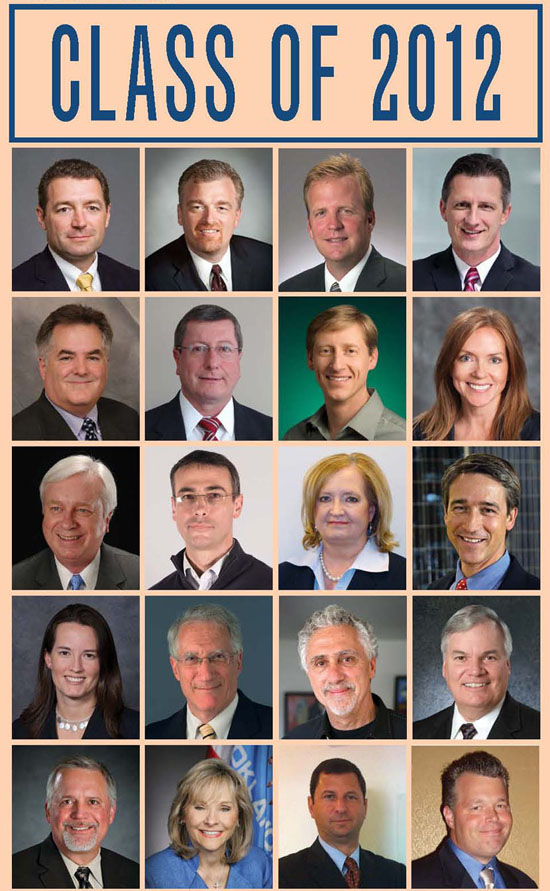 |
Class of 2012
2012 is an election year and a leap year! Campaigning to be elected is not much different from a publication campaigning to be selected. It’s based solely on making comparisons of the candidates and
the publications. World-Gen invites comparison of its editorial platform starting with the Class of 2012,
our thirteenth Class of the millennium.
Toby Seay, president of Bechtel Power’s Communication and Transmission business line, says changes
are coming for transmission on page 4. The biggest demand now is for upgrading existing transmission
lines. He is looking with interest to potential wind farms along the Atlantic coast as well as off the coast
of Britain.
Paul Browning, CEO of GE’s Thermal Products said the world’s energy mix has changed over the
past decade on page 5. He believes that the greater use of renewable energy, in combination with natural
gas, is the future of power generation. GE has invested more than $500 million to develop its
FlexEfficiency technology.
KeyBanc has 13 projects underway, and is handling eight transactions – primarily in wind and
solar energy with potential output of 1,119 MW. On page 6, Andy Redinger projects a potential source of
new financing could be real estate investment trust (REIT) capital.
|
Siemens Energy has over 7,000 employees in Latin America, nearly 1,000 working in Energy
Services, Tim Frace shares on page 7. The strategy of regionalization puts the Energy Service teams in
all key countries to go one-on-one with their customers and be in a position to offer other Siemens global
competencies.
With more than one million power products installed, Steve Levy of Advanced Energy on page 8 is
developing and field-testing technologies focused on lowering the barriers to adopting solar energy on
North American utility grids.
Hitachi Power Systems America signed a licensing agreement for design and supply of fabric filter
technology developed by Balcke Durr. Robert Nicolo explains Hitachi’s market participation on page 9.
Google invested nearly a billion dollars in a renewable energy portfolio of 1.7 gw’s, Rick Needham
tells us on page 10. He hopes to inspire other companies and investors to participate in the clean energy
revolution and together explore other possibilities.
RES Americas has been active in North America since 1997 working on more than 4,800 megawatts
of renewable energy projects, Susan Reilly said on page 11. Its 360 employees provide technical
expertise in wind and solar, transmission and construction.
PIC’s focus on teamwork ensures that their working environments are as safe as they can be, Dirk
Rountree said on page 12. PIC’s six complementary service lines can manage an entire project lifecycle by
bundling services.
Following acquisitions of Energy Recommerce and Act Solar, Power-One offers a holistic portfolio of
products and solutions. Paolo Casini sees the main objective is to meet customer needs by providing panel-
to-grid system solution, on page 13.
Zurich Energy offers more than 70 risk management services and 17 online tools to help mitigate
losses and reduce both operational and financial risks to meet all the needs of alternative energy producers
and manufacturers, Jeanne Jankowski, CEO says on page 14.
John LeFebvre of Suntech believes there is a strong immediate opportunity for solar and natural gas
to work together, particularly as a bridging solution away from coal. On page 15, he anticipates new or
steady solar policy support from many states.
Solar power is the fastest growing energy resource in the U.S., and its once high price tag is falling
rapidly, Julia Hamm, president of SEPA, points out on page 16. Electric utilities signed power purchase
agreements for less than 10 cents per kilowatt-hour.
Marvin Fertel on page 17 tells of two major imperatives at the Nuclear Energy Institute: to maintain
and increase the asset value of 104 operating plants and second to ensure that we maintain and
grow the capability to build new nuclear plants.
Ron Kenedi of LDK Solar said on page 17 that the cost of electricity is constantly going up – 3% to
8% annually, while solar costs are moving downward. The important point is where they merge.
It would behoove the industry to pursue a diversified fuel portfolio strategically to ensure we mitigate
reliability risk and provide the best technological stability possible, Dave Dunning of Fluor said on page 18.
NERC is an international, independent, not-for-profit organization, whose mission is to ensure the
reliability of the bulk power system in North America, CEO Gerry Cauley says on page 19.
OKLAHOMA Governor Mary Fallin unveiled her First Energy Plan on page 20. Her agenda is
built around the belief that we must continue to improve, not replace, traditional energy sources.
Charles Dauber sees three key growing energy markets AETI is targeting for products and turnkey
solutions in 2012 on page 21. North American shale plays, global energy, and utility-scale solar are markets
AETI has served.
The energy industry is in a transformational state, Brian Huey says on page 22. Sprint collaborates
with companies to embed wireless technology into solutions that automate meters and monitor distribution
lines so that utilities can be more efficient.
|
